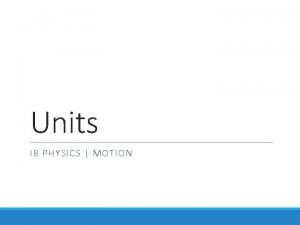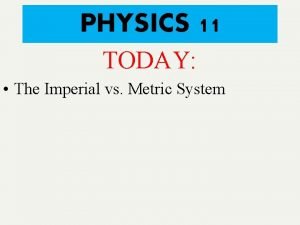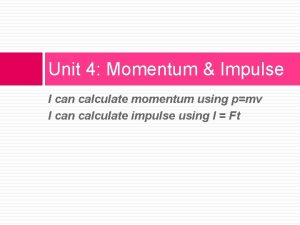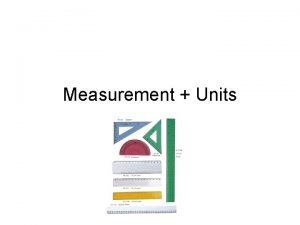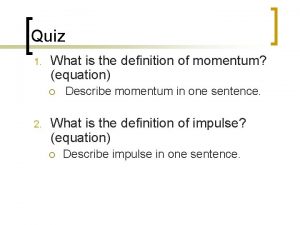UNITS IN PHYSICS PES 1000 PHYSICS IN EVERYDAY







- Slides: 7

UNITS IN PHYSICS PES 1000 – PHYSICS IN EVERYDAY LIFE

WHY ARE UNITS IMPORTANT? • Units allow us to quantify physical measurements • Units allow us to compare physical quantities across all branches of science • We can study physical relationships without units, but we need units to relate the physics to our everyday experiences • We can check the correctness of formulas by finding if the units properly combine • Units can be accurately standardized so that many people can compare their results

CONSIDERATIONS WHEN CHOOSING A SET OF UNITS • Completeness: The units should be able to characterize all measurable physical properties • Independence: There should be no overlap • Two distinct units shouldn’t depend on the same physical property • Measurability: It should be possible to accurately measure something to base a standard unit upon • It is better that the something be a property of nature, not an artifact, or man-made object • Usability: Units should be of a reasonable size relative to typical properties measured • Not too big, not too small • Scalability: Conversion between different scales of objects should be convenient (powers of 10)

THE INTERNATIONAL SYSTEM OF UNITS • Called the S. I. units (for Système International d 'unites) • Adopted by all of the countries in the world except three • Conversions involve powers of ten (moving the decimal point): 1000. meters is 1. 000 kilo-meters • Based on physical measurements of nature that can be performed by anyone • Not based on physical artifacts (exception: the kilogram)

THE INTERNATIONAL SYSTEM OF UNITS Length – the meter (m) Mass – the kilogram (kg) Time – the second (s) Current – the Ampere (A) Intensity – the candela (cd) Temperature – the Kelvin (K) Amount of substance – mole (mol)

THE U. S. CUSTOMARY UNITS • Formerly called British or English units • Only used in the United States of America, Liberia, and Burma • Originally based on the general size of easily available ‘items’ • Foot – based on an average foot size • Inch – about the size of the first knuckle of a finger • Yard – approximately the size of a stride • Hand (for measuring horses) – the width of an average hand • Fahrenheit – This temperature scale is suited to the comfort levels of people • Requires memorizing conversion factors: 12 inches is a foot, 5280 feet in a mile, 3 feet in a yard, etc.

CONCLUSION • This class will be primarily concerned with SI units • All formulas given (unless otherwise stated) will assume SI units • I’ll also occasionally present US Customary units and their relation to SI units to give those of us raised with our antiquated unit system a sense of their SI system equivalents


